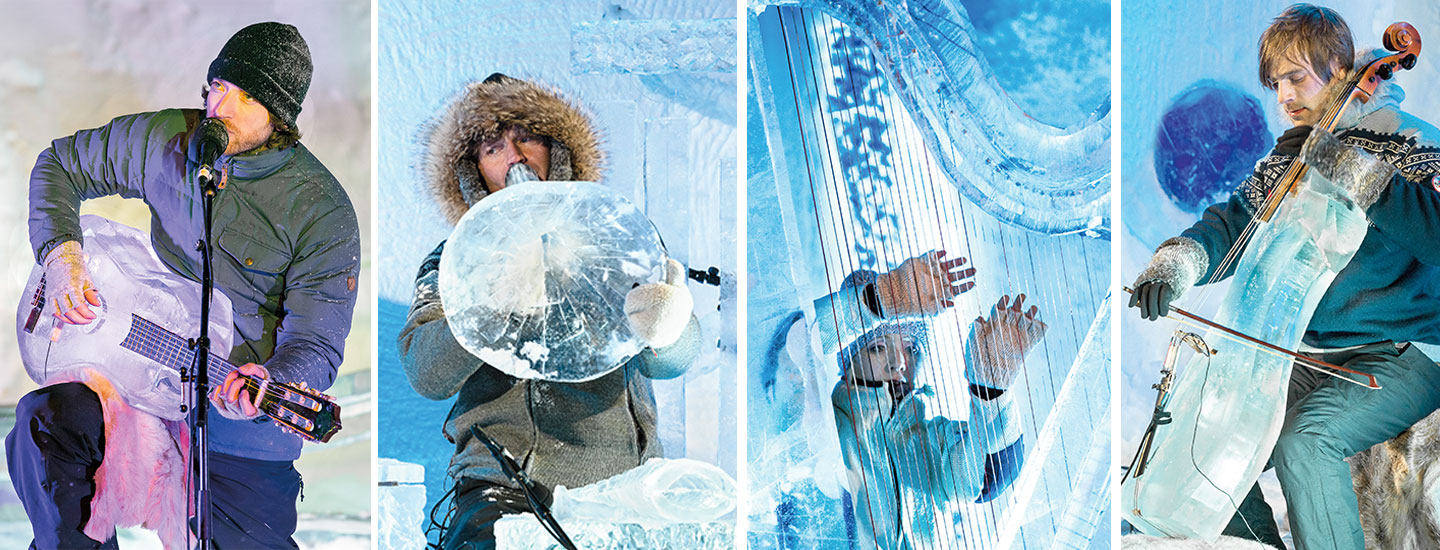NGSS: Core Idea: PS1.A
CCSS: Reading Informational Text: 4
TEKS: Science: 3.5C, 4.5C, 5.5A, 6.9B; ELA: 3.3A, 3.6F, 4.3A, 4.6F, 5.3A, 5.6F, 6.2A, 6.5F

Festival musicians play (left to right) a guitar, a horn, a harp, and a cello—all made of ice!
Emile Holba Photography
Standards
NGSS: Core Idea: PS1.A
CCSS: Reading Informational Text: 4
TEKS: Science: 3.5C, 4.5C, 5.5A, 6.9B; ELA: 3.3A, 3.6F, 4.3A, 4.6F, 5.3A, 5.6F, 6.2A, 6.5F
The Coldest Concert
At a festival in Norway, artists play instruments made of ice!
Jim McMahon
Every February, hundreds of people make their way to the frigid town of Finse, Norway. There, they brave temperatures far below freezing to attend a series of special outdoor concerts. Every instrument the musicians play—and even the stage they play on—is made almost entirely of ice!
This event is called the Ice Music Festival. Musicians and artists work together to carve everything from horns to guitars. Festival founder Terje Isungset (TAHR-yeh EE-soong-set) built his first ice instrument 20 years ago. “When I heard the sound of ice, I fell in love with it,” he says.
Every February, hundreds of people travel to Finse, Norway. The town is frigid in the winter. But visitors brave temperatures far below freezing. They come to see a series of special outdoor concerts. Every instrument played is made almost entirely of ice. Even the stage the musicians perform on is frozen!
The event is called the Ice Music Festival. Musicians and ice sculptors work together. They carve everything from horns to guitars. Terje Isungset (TAHR-yeh EE-soong-set) founded the festival. He built his first ice instrument 20 years ago. “When I heard the sound of ice, I fell in love with it,” he says.
Cool Carving
Preparations for the festival begin about a week before opening night. Workers use large saws to cut giant blocks of ice from frozen lakes near Finse. Each block weighs about 1,600 kilograms (3,527 pounds)!
Carving each instrument can take up to 12 hours, says Bill Covitz. He’s an ice carver from Connecticut who helps with the festival almost every year. To start an instrument, Covitz cuts the rough shape with a chainsaw. He uses smaller tools, like chisels, to shape finer details. Carvers work outside, where the air is usually about -7°C (19°F) in the winter. That’s well below water’s freezing point of 0°C (32°F).
To hollow out a horn, Covitz slices a piece of ice down the middle. Then he carves a groove in each half for the musician to blow through. Finally, he puts the halves together and sprays them with water. The water quickly freezes solid, sticking the two halves in place.
People get ready for the festival about a week before opening night. Workers use large saws. They cut giant blocks of ice. The ice comes from frozen lakes near Finse. Each block weighs about 1,600 kilograms (3,527 pounds)!
Carving each instrument can take up to 12 hours, says Bill Covitz. He’s an ice carver from Connecticut. He helps with the festival almost every year. Covitz first cuts the rough shape of an instrument. He uses a chainsaw. Then he uses smaller tools, like chisels. He cuts the shape’s finer details. Carvers work outside. The outside air is usually about -7°C (19°F) in the winter. That’s well below water’s freezing point of 0°C (32°F).
Some instruments, like horns, are hollow. Covitz creates them by slicing a piece of ice down the middle. Then he carves a groove in each half. The groove is for the musician to blow through. Finally, Covitz puts the halves together. He sprays them with water. The water quickly freezes solid. That sticks the two halves in place.
THIBAUT VERGOZ/ZEPPELIN/SIPA/Newscom
Festival founder Terje Isungset uses a chainsaw to carve a horn out of ice.
Showtime!
An ice concert is a chilly experience. Musicians perform at night, when the temperature drops as low as -26°C (-15°F). The cold makes the music better, says Covitz. “The instruments sing beautifully,” he says.
Warmer air can cause the ice to soften. If an instrument gets too warm, parts of it will start to melt into liquid. That can dull the sound. This sometimes happens during performances, when a musician’s breath heats up a horn. But Isungset thinks that keeps ice music interesting. “My favorite thing is when the audience gets surprised.”
An ice concert is a chilly event. Musicians perform at night. The temperature drops as low as -26°C (-15°F). The cold makes the music better, says Covitz. “The instruments sing beautifully,” he says.
Warmer air can cause the ice to soften. Parts of an instrument will start to melt into liquid. That can dull the sound. This sometimes happens during a concert. For example, a musician’s breath can heat up a horn. But Isungset thinks that keeps ice music interesting. “My favorite thing is when the audience gets surprised.”